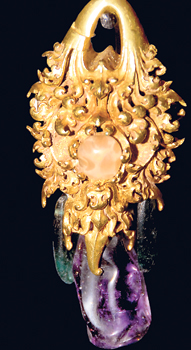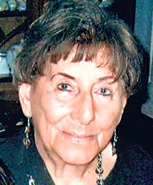Oft did she wonder what life would have been atop the rock, particularly for the women.
Did they cook, what did they eat, did they (because there would have been many) have to fight for the attention of the men, were they lonely, did they live in fear…….?
These and many more questions, the answers to which were elusive so many centuries later, kept crossing Anne Ranasinghe’s mind, every time she clambered up the forbidding face of Sigiriya, the Lion Rock, and looked down on the vast plains seeing a sea of trees…….impenetrable, mysterious and dangerous.
 |
| Ear Ornament: (c. 5th AD); L. 6.4 cm (with pendant stone); Provenance uncertain (Sigiriya?); Gem-set Gold Design, Solid Cast - The ear-ornament (Kundala) made with intricate circles fitted with gems is the most unique ornament of this class. The beautiful design and style show classical qualities executed by a master jeweller who was possibly knowledgeable in the artistic talents of the Sigiriya painters, so much so that this ear-ornament is considered to have belonged originally to Sigiriya.
(Colombo Museum) |
Far from the remote rock fortress, in the stately Colombo Museum it was that the lines sprang up, triggered by the magnificent sight of just one dangling ear ornament. And that is the poem, ‘Museum Piece – Sigiriya Ear Ornament’ (see box) which has won first prize at the Artists Embassy International 15th Annual Dancing Poetry Festival on September 27, in San Francisco, United States of America.
“That ear-ring couldn’t be ignored. I was intrigued,” smiles Mrs. Ranasinghe, internationally renowned poet and short-story writer, who needs no introduction, when I meet her at her home on Rosmead Place, Colombo 7.
It was written a long time ago, as far back as 1972, and had all but been ignored, until it won the award this September, she explains, adding “maybe people didn’t understand it” because one needs to have an intimate knowledge of Sigiriya to fully appreciate the deeply emotive stanzas.
The moment something catches her imagination, the line scheme and rhyme scheme come into her head. A word here and a line there. “I write about things I know. It is a gift from somewhere,” says Mrs. Ranasinghe who has also published radio plays, essays and translations. She is a Founder Member of the English Writers Cooperative of Sri Lanka and had worked as Executive Secretary of the Amnesty International South Asia Publications Service for 15 years.
Both poems and short stories she carries “in my head” and both undergo many drafts once she sits at her electric typewriter to ensure that “every word is in its proper place”. Even to change one single word, she would type out the whole poem again. “I love doing it,” adds Mrs. Ranasinghe quickly to dispel misconceptions that it is a drudgery.
The fascination with the “Cultural Triangle” sites came when she accompanied husband, well-known Prof. D.A. Ranasinghe (Professor of Obstetrics and Gynaecology, University of Colombo and later Chancellor) and children to see the country, including Polonnaruwa and Dambulla.
As a young doctor, Prof. Ranasinghe had served in Polonnaruwa, then a jungle town, at a time when the drinking water had to be taken from Colombo. Many had been the visits by D.S. Senanayake (later the first Premier) and C.P. de Silva (later an Irrigation Minister) to Polonnaruwa to plan out irrigation schemes and those were the days when they would sleep rough at the hospital along with Prof. Ranasinghe.
 |
| Anne Ranasinghe |
“My husband was a patriot, he loved the land,” says Mrs. Ranasinghe and he was the one who insisted that she and the children must see the country. “Wonderful times, with the children swimming in the Parakrama Samudra,” she reminisces. It was also a time of new and exciting discoveries at Sigiriya.
But the writings, poetry and short stories, came much later. “I started writing when I was quite old,” she says, although she had dabbled in it as a child. For she had to look after, which she did very willingly, a “gang of children”, three from her husband’s earlier marriage and four from their own.
This was in addition to having to grapple with differences in culture, with no idea what she was in for at 26, when she accompanied her husband to Sri Lanka. “I was stuck between two worlds,” she says, “but people have been good to me.”
Fleeing from the Holocaust in Germany, just before World War II as a child, Mrs. Ranasinghe had studied in the south of England, away from family and home, starting only with a smattering of English. But she could not put the persecution of the Jews behind her, for both her father and mother had been gassed to death with engine exhaust in July 1944 in Poland.
It was in England that her English teacher inspired her. “I loved her very much and wanted to please her as children are wont to do,” she says.
Later it was training to be a nursing sister, marriage to Prof. Ranasinghe and finding herself in a country far away from the land of her birth and also England. Going to her husband’s village, Divulapitiya, and finding the women seated together, learning the art of eating rice and curry with her fingers and also seeing the beautiful countryside as proudly shown off by her husband were all part of her life.
Polonnaruwa, Dambulla and Sigiriya, places about which she has written three poems, come often into her conversation. The harsh, sun-seared scrubland, suddenly giving way to acres and acres of lush green paddyfields, the result of far-reaching irrigation schemes. “My husband was so proud as if he had built the schemes himself,” she says with nostalgia.
Polonnaruwa, sans the rash of kades now visible, with its huge statues inspired her. “You wanted to sit down, reflect on what life was all about, on death and also eternity,” says Mrs. Ranasinghe, adding that her favourite is the little statue that sits in a cage. She writes off Anuradhapura as “too commercialized” but relives the moment she saw a snake charmer and his two snakes on Dambulu rock.
Amidst the travel and the socializing, she did write poetry again when her youngest was about eight. But she couldn’t judge whether her works were good or bad. That was when she joined the Polytechnic to study journalism and law, leaving her husband and children aghast. “The atmosphere at the Polytechnic was fantastic, the class, the ink, the writing. Enjoyed every minute of it,” she says.
The first of her poems to be accepted by the then Editor of the Daily News Mervyn de Silva, and published on the Editorial Page was ‘I had expected tears’. The response, of course, was immense.
Etched forever in her mind is the day she drove her nine-year-old daughter to the airport. She was to attend a swimming meet in Singapore.
As the children walked across the tarmac, Mrs. Ranasinghe, held her breath, like any mother would, thinking the little girl would break down and weep.
While all the other children turned back and waved to their mothers, her daughter skipped along and boarded the flight without a backward glance at her. It was when Mrs. Ranasinghe was driving back home thinking of her heart-rending unfulfilled wish that her daughter would turn back just once and wave goodbye, that ‘I had expected tears’ filled her mind.
Now many years later, with her own family leaving the nest and many awards, both local and international to her credit (recently six of her poems have been included in the syllabus for the 60th Hong Kong Schools Speech Festival November 17 – December 17 which receives about 180,000 entries) what lies ahead for Mrs. Ranasinghe?
While suggesting that her poems on Polonnaruwa, Dambulla and Sigiriya along with photographs could be the stuff of books that would promote Sri Lanka, Mrs. Ranasinghe, 83 who says she lives “from day to day” hopes for a clear table.
When she is able to clear her table of all the work, she says, will come “My story”.
That indeed would be an interesting read like her passionate poetry.
Museum Piece – Sigiriya Ear Ornament
What delicate ear
Hosted this ornament?
Was she beautiful, this lady,
Swaying her days through the windy galleries,
Was she haughty
Or gentle?
Maid
Or courtesan?
And what thoughts
As she waited
High on her rock
In the marble-white palace
With jewelled finials,
Glancing down perhaps
On the flickering wicks –
A hundred wicks flickering
Deep
Deep below
Where the jungle night
Flowed
A black impenetrable river.
Did she resent her confinement.
Or was it love?
He plays with her hair,
His restless hands span
Her slender throat –
Time flares – they span
The centuries
As one gold-faceted ear-ring
Drops.
Sentries of the jungle night
Do not sleep.
Narrow
Is the ledge of your vigil,
Steep
The fall –
Did your hand not tremble
As you painted your dream
on the wall
Of your fear?
Beware
The enemy is near.
Out of another life
Out of a vague
And distant time
One
Ear
Ornament. |


